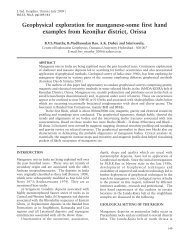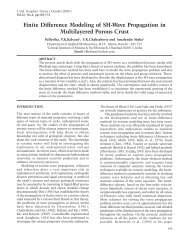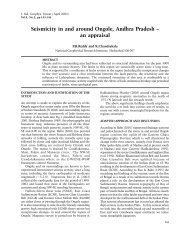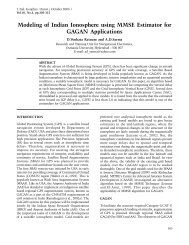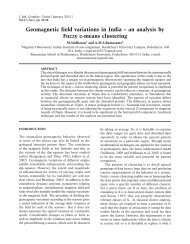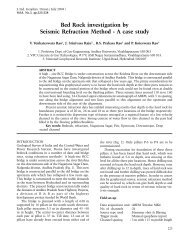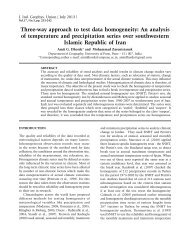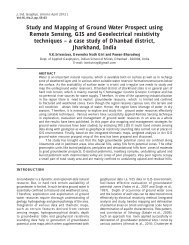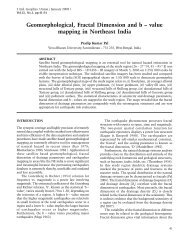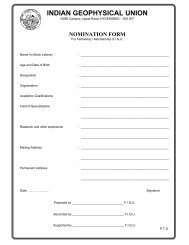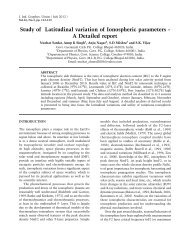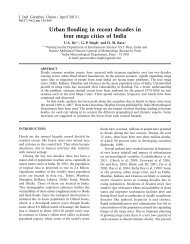What to trust in a Magnetotelluric Model? - IGU
What to trust in a Magnetotelluric Model? - IGU
What to trust in a Magnetotelluric Model? - IGU
Create successful ePaper yourself
Turn your PDF publications into a flip-book with our unique Google optimized e-Paper software.
K.K.Roy et al.<strong>in</strong>terpretation. We cannot choose one of these modelsas a true representative of the subsurface structure.Mathematical ModeL EXPERIMENT<strong>Model</strong> 1: Fig.4(a) shows a 3D model of a 100 km. cubeof resistivity 5000 ohm-m. with 3 graben type ofstructures. The dimensions of these three structuresare respectively given by (i) left graben : width 2km.,depth 40 km., resistivity of the rock fill<strong>in</strong>g the graben50 ohm.m, (ii) central graben : width 20 km. anddepth 25 km., resistivity of the rocks fi<strong>in</strong>g the grabenis assumed <strong>to</strong> be 200 ohm-m. and (iii) right graben :width 1 km. and depth 30 km., resistivity of thematerial fill<strong>in</strong>g the graben is 10 ohm-m.Figs 4(b) and (c) show the TM and TE modeapparent resistivity pseudosections obta<strong>in</strong>ed from 3Df<strong>in</strong>ite difference source code of Mackie, Madden &Wannamaker (1993). The ord<strong>in</strong>ate, time period, is <strong>in</strong>log <strong>to</strong> the base 10 scale. The abscissa is distance <strong>in</strong>kilometer. The two apparent resistivity pseudosectionsshow that the TM mode apparent resistivities aresuperior <strong>to</strong> the TE mode apparent resistivities <strong>in</strong>resolv<strong>in</strong>g vertical faults, dykes etc.<strong>Model</strong> 2: Fig.5 (a) shows a model of a 100 km. cubeof resistivity 5000 ohm-m. Four dykes of width 100meters, depth extent 10 km. and mutual separationof 2km. between these dykes are assumed. Thesedykes are assumed at a depth of 500 meters from thesurface. Resistivity of the rocks fill<strong>in</strong>g the grabenstructures is assumed <strong>to</strong> be 20 ohm-m.Figs 5(b) and (c) show respectively the TE modeapparent resistivity and phase profile across thesedykes. Figs. 5(d) and (e) show the TM mode apparentresistivity and phase profiles across these dykes. Figs5(d) and (e) show that both TM mode apparentresistivity and phase profiles could resolve all the dykesseparately. TE mode apparent resistivity and phaseprofiles failed <strong>to</strong> resolve the presence of the four dykes.<strong>Model</strong> 3: Fig.6 (a) shows a 100 km. cube ofresistivity 5000 ohm-m. <strong>in</strong> which a conduct<strong>in</strong>g dykeof width 15 meter is assumed. Resistivity of thematerials fill<strong>in</strong>g the dyke is taken <strong>to</strong> be 10 ohm-m.and the depth of the dyke was varied from 15 m. <strong>to</strong> 1km. Figs 6(b) and (c) show the TM and TE modeprofiles across the dyke. The two figures clearly showthat TM mode MT has immensely superior resolv<strong>in</strong>gpower than the TE mode MT. TE mode MT sees thetarget from a greater distance. As a result biggervolume of earth materials are <strong>in</strong>volved <strong>in</strong> generat<strong>in</strong>gthe TE mode response.These three sets of model experiments clearlyshow that the resolv<strong>in</strong>g power of the TM moderesponse is very much different from that of the TEmode response. Electric and magnetic fields paralleland perpendicular <strong>to</strong> the strike direction of thestructures reflect very much different physicalproperties of the earth. Discrepancies <strong>in</strong> these modelspartly come from theory and partly come from the<strong>in</strong>homogeneities and anisotropies of the subsurface.Common features <strong>in</strong> the modelsStrong data with m<strong>in</strong>imum noise content will alwaysshow some common features <strong>in</strong> all the models evenafter us<strong>in</strong>g different <strong>in</strong>version source codes anddifferent MT parameters. Geometrical shapes of thesemajor features may be different. Some of the m<strong>in</strong>orsignatures may be different <strong>in</strong> different modelsobta<strong>in</strong>ed from different magne<strong>to</strong>telluric parameters. 2Dquantitative models should be accepted <strong>in</strong> asemiquantitative way and the broad features, whichare common <strong>in</strong> all the models, should be taken withgreater degree of confidence. If several earth modelshave someth<strong>in</strong>g common, then earth must have thatproperty (Bachus & Gilbert 1967). All the three TE,TM and (TE+TM) models presented <strong>in</strong> the Figs 3b,c and d show the blackish high conductivity zone. Thegeometrical shapes of these zones are different <strong>in</strong>different models. All the three models show that thecont<strong>in</strong>ent is rifted <strong>in</strong> this area. These parts arecommon <strong>in</strong> all the three models and can be acceptedFigure 3(a). Shows the location map of the Khandwa-Ujja<strong>in</strong> traverse.160



